Talent Management Strategies: Attracting & Retaining Talent at Walker
VerifiedAdded on 2023/06/18
|25
|4946
|273
Report
AI Summary
This report analyzes talent management strategies adopted by Walker Logistics, a European and UK-based outsourced logistics provider, to retain and attract employees. It explores the concept of talent management, identifies key strategies such as skill development, on-the-job training, and career succession planning, and addresses challenges like poor hiring strategies and ineffective leadership. The research employs both primary data, gathered through questionnaires, and secondary data from literature reviews. Findings reveal the importance of understanding talent management, implementing effective strategies, and overcoming challenges to enhance organizational performance and employee retention within SMEs like Walker Logistics. Desklib provides access to similar solved assignments and past papers for students.
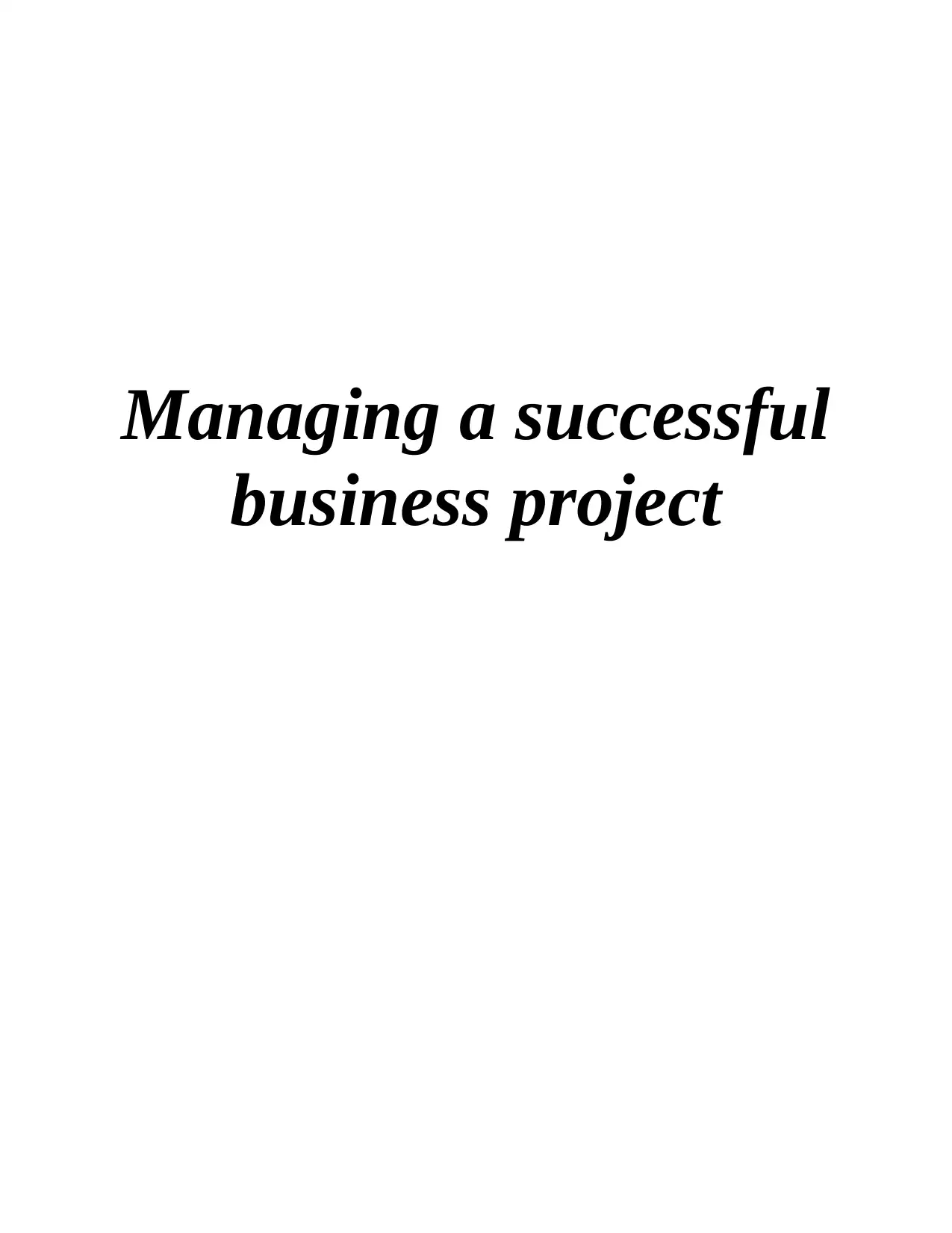
Managing a successful
business project
business project
Paraphrase This Document
Need a fresh take? Get an instant paraphrase of this document with our AI Paraphraser
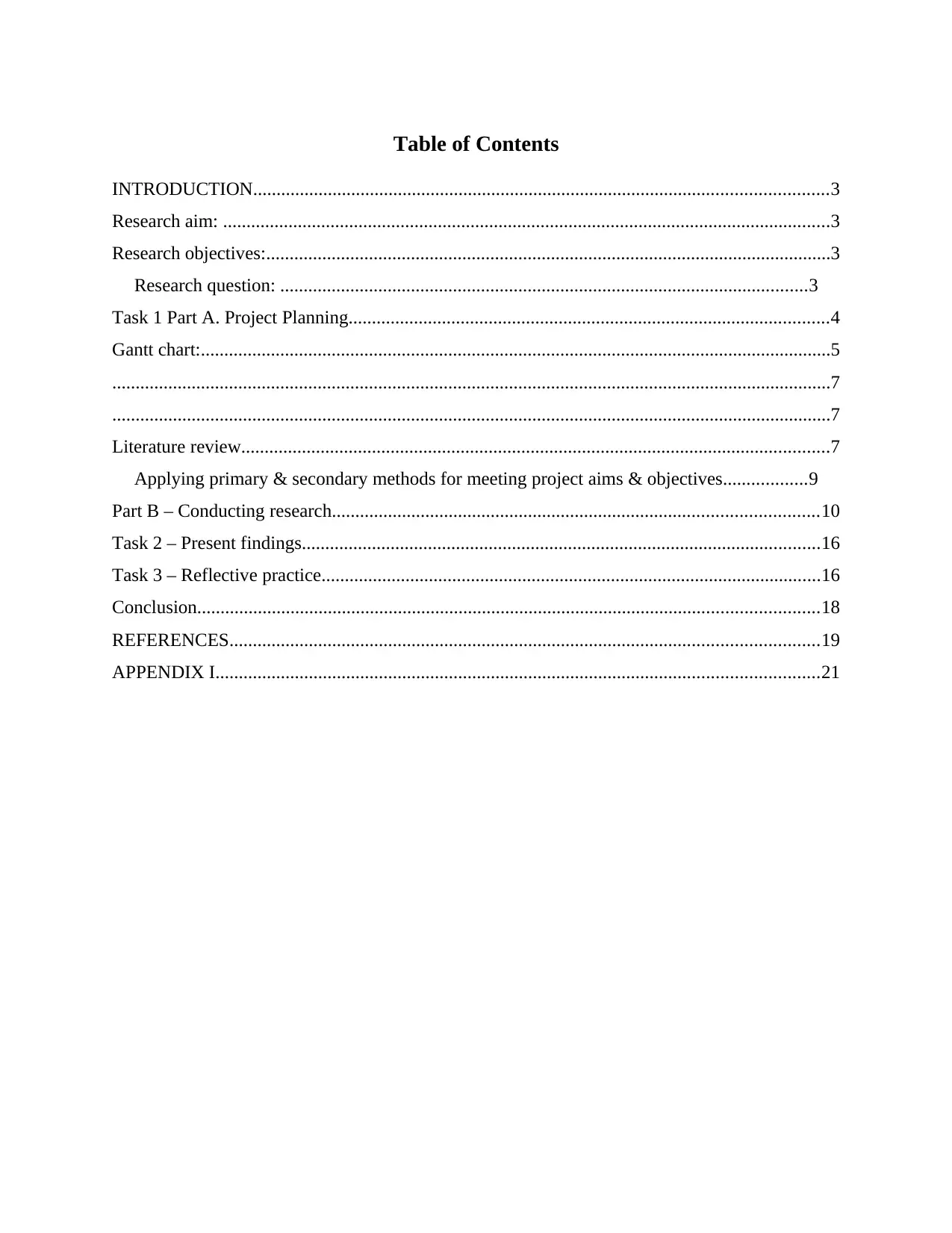
Table of Contents
INTRODUCTION...........................................................................................................................3
Research aim: ..................................................................................................................................3
Research objectives:.........................................................................................................................3
Research question: .................................................................................................................3
Task 1 Part A. Project Planning.......................................................................................................4
Gantt chart:.......................................................................................................................................5
..........................................................................................................................................................7
..........................................................................................................................................................7
Literature review..............................................................................................................................7
Applying primary & secondary methods for meeting project aims & objectives..................9
Part B – Conducting research........................................................................................................10
Task 2 – Present findings...............................................................................................................16
Task 3 – Reflective practice...........................................................................................................16
Conclusion.....................................................................................................................................18
REFERENCES..............................................................................................................................19
APPENDIX I.................................................................................................................................21
INTRODUCTION...........................................................................................................................3
Research aim: ..................................................................................................................................3
Research objectives:.........................................................................................................................3
Research question: .................................................................................................................3
Task 1 Part A. Project Planning.......................................................................................................4
Gantt chart:.......................................................................................................................................5
..........................................................................................................................................................7
..........................................................................................................................................................7
Literature review..............................................................................................................................7
Applying primary & secondary methods for meeting project aims & objectives..................9
Part B – Conducting research........................................................................................................10
Task 2 – Present findings...............................................................................................................16
Task 3 – Reflective practice...........................................................................................................16
Conclusion.....................................................................................................................................18
REFERENCES..............................................................................................................................19
APPENDIX I.................................................................................................................................21
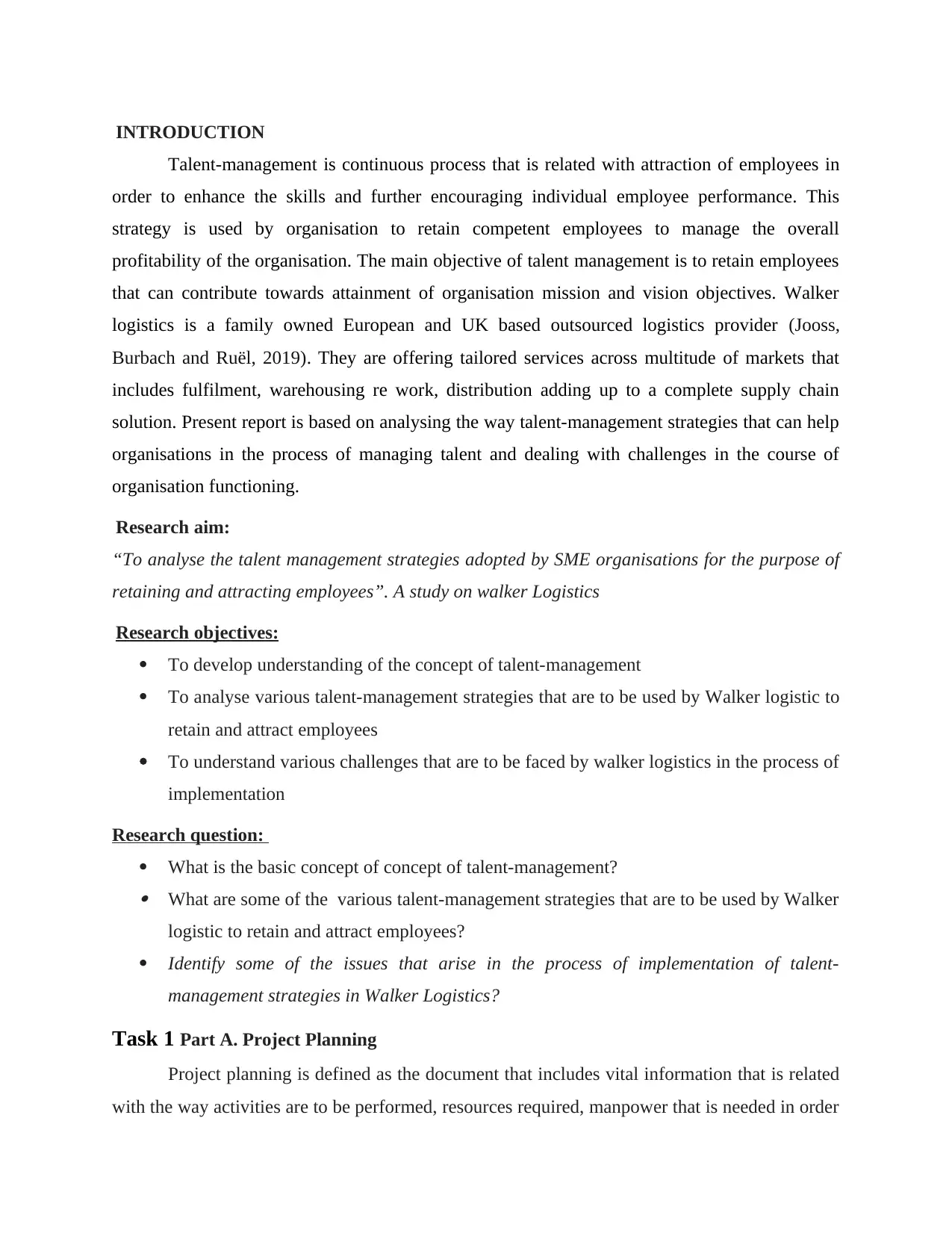
INTRODUCTION
Talent-management is continuous process that is related with attraction of employees in
order to enhance the skills and further encouraging individual employee performance. This
strategy is used by organisation to retain competent employees to manage the overall
profitability of the organisation. The main objective of talent management is to retain employees
that can contribute towards attainment of organisation mission and vision objectives. Walker
logistics is a family owned European and UK based outsourced logistics provider (Jooss,
Burbach and Ruël, 2019). They are offering tailored services across multitude of markets that
includes fulfilment, warehousing re work, distribution adding up to a complete supply chain
solution. Present report is based on analysing the way talent-management strategies that can help
organisations in the process of managing talent and dealing with challenges in the course of
organisation functioning.
Research aim:
“To analyse the talent management strategies adopted by SME organisations for the purpose of
retaining and attracting employees”. A study on walker Logistics
Research objectives:
To develop understanding of the concept of talent-management
To analyse various talent-management strategies that are to be used by Walker logistic to
retain and attract employees
To understand various challenges that are to be faced by walker logistics in the process of
implementation
Research question:
What is the basic concept of concept of talent-management? What are some of the various talent-management strategies that are to be used by Walker
logistic to retain and attract employees?
Identify some of the issues that arise in the process of implementation of talent-
management strategies in Walker Logistics?
Task 1 Part A. Project Planning
Project planning is defined as the document that includes vital information that is related
with the way activities are to be performed, resources required, manpower that is needed in order
Talent-management is continuous process that is related with attraction of employees in
order to enhance the skills and further encouraging individual employee performance. This
strategy is used by organisation to retain competent employees to manage the overall
profitability of the organisation. The main objective of talent management is to retain employees
that can contribute towards attainment of organisation mission and vision objectives. Walker
logistics is a family owned European and UK based outsourced logistics provider (Jooss,
Burbach and Ruël, 2019). They are offering tailored services across multitude of markets that
includes fulfilment, warehousing re work, distribution adding up to a complete supply chain
solution. Present report is based on analysing the way talent-management strategies that can help
organisations in the process of managing talent and dealing with challenges in the course of
organisation functioning.
Research aim:
“To analyse the talent management strategies adopted by SME organisations for the purpose of
retaining and attracting employees”. A study on walker Logistics
Research objectives:
To develop understanding of the concept of talent-management
To analyse various talent-management strategies that are to be used by Walker logistic to
retain and attract employees
To understand various challenges that are to be faced by walker logistics in the process of
implementation
Research question:
What is the basic concept of concept of talent-management? What are some of the various talent-management strategies that are to be used by Walker
logistic to retain and attract employees?
Identify some of the issues that arise in the process of implementation of talent-
management strategies in Walker Logistics?
Task 1 Part A. Project Planning
Project planning is defined as the document that includes vital information that is related
with the way activities are to be performed, resources required, manpower that is needed in order
⊘ This is a preview!⊘
Do you want full access?
Subscribe today to unlock all pages.

Trusted by 1+ million students worldwide
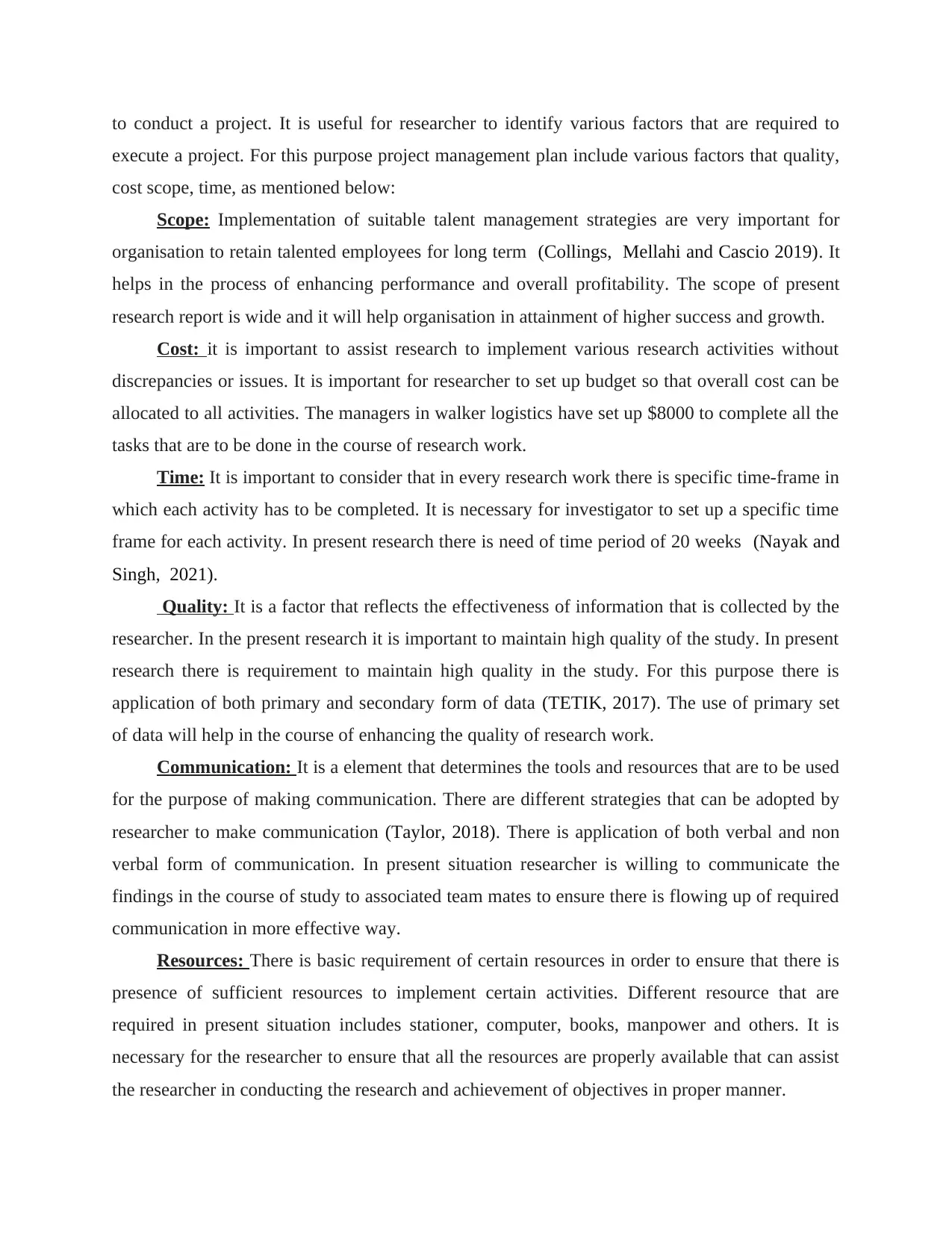
to conduct a project. It is useful for researcher to identify various factors that are required to
execute a project. For this purpose project management plan include various factors that quality,
cost scope, time, as mentioned below:
Scope: Implementation of suitable talent management strategies are very important for
organisation to retain talented employees for long term (Collings, Mellahi and Cascio 2019). It
helps in the process of enhancing performance and overall profitability. The scope of present
research report is wide and it will help organisation in attainment of higher success and growth.
Cost: it is important to assist research to implement various research activities without
discrepancies or issues. It is important for researcher to set up budget so that overall cost can be
allocated to all activities. The managers in walker logistics have set up $8000 to complete all the
tasks that are to be done in the course of research work.
Time: It is important to consider that in every research work there is specific time-frame in
which each activity has to be completed. It is necessary for investigator to set up a specific time
frame for each activity. In present research there is need of time period of 20 weeks (Nayak and
Singh, 2021).
Quality: It is a factor that reflects the effectiveness of information that is collected by the
researcher. In the present research it is important to maintain high quality of the study. In present
research there is requirement to maintain high quality in the study. For this purpose there is
application of both primary and secondary form of data (TETIK, 2017). The use of primary set
of data will help in the course of enhancing the quality of research work.
Communication: It is a element that determines the tools and resources that are to be used
for the purpose of making communication. There are different strategies that can be adopted by
researcher to make communication (Taylor, 2018). There is application of both verbal and non
verbal form of communication. In present situation researcher is willing to communicate the
findings in the course of study to associated team mates to ensure there is flowing up of required
communication in more effective way.
Resources: There is basic requirement of certain resources in order to ensure that there is
presence of sufficient resources to implement certain activities. Different resource that are
required in present situation includes stationer, computer, books, manpower and others. It is
necessary for the researcher to ensure that all the resources are properly available that can assist
the researcher in conducting the research and achievement of objectives in proper manner.
execute a project. For this purpose project management plan include various factors that quality,
cost scope, time, as mentioned below:
Scope: Implementation of suitable talent management strategies are very important for
organisation to retain talented employees for long term (Collings, Mellahi and Cascio 2019). It
helps in the process of enhancing performance and overall profitability. The scope of present
research report is wide and it will help organisation in attainment of higher success and growth.
Cost: it is important to assist research to implement various research activities without
discrepancies or issues. It is important for researcher to set up budget so that overall cost can be
allocated to all activities. The managers in walker logistics have set up $8000 to complete all the
tasks that are to be done in the course of research work.
Time: It is important to consider that in every research work there is specific time-frame in
which each activity has to be completed. It is necessary for investigator to set up a specific time
frame for each activity. In present research there is need of time period of 20 weeks (Nayak and
Singh, 2021).
Quality: It is a factor that reflects the effectiveness of information that is collected by the
researcher. In the present research it is important to maintain high quality of the study. In present
research there is requirement to maintain high quality in the study. For this purpose there is
application of both primary and secondary form of data (TETIK, 2017). The use of primary set
of data will help in the course of enhancing the quality of research work.
Communication: It is a element that determines the tools and resources that are to be used
for the purpose of making communication. There are different strategies that can be adopted by
researcher to make communication (Taylor, 2018). There is application of both verbal and non
verbal form of communication. In present situation researcher is willing to communicate the
findings in the course of study to associated team mates to ensure there is flowing up of required
communication in more effective way.
Resources: There is basic requirement of certain resources in order to ensure that there is
presence of sufficient resources to implement certain activities. Different resource that are
required in present situation includes stationer, computer, books, manpower and others. It is
necessary for the researcher to ensure that all the resources are properly available that can assist
the researcher in conducting the research and achievement of objectives in proper manner.
Paraphrase This Document
Need a fresh take? Get an instant paraphrase of this document with our AI Paraphraser
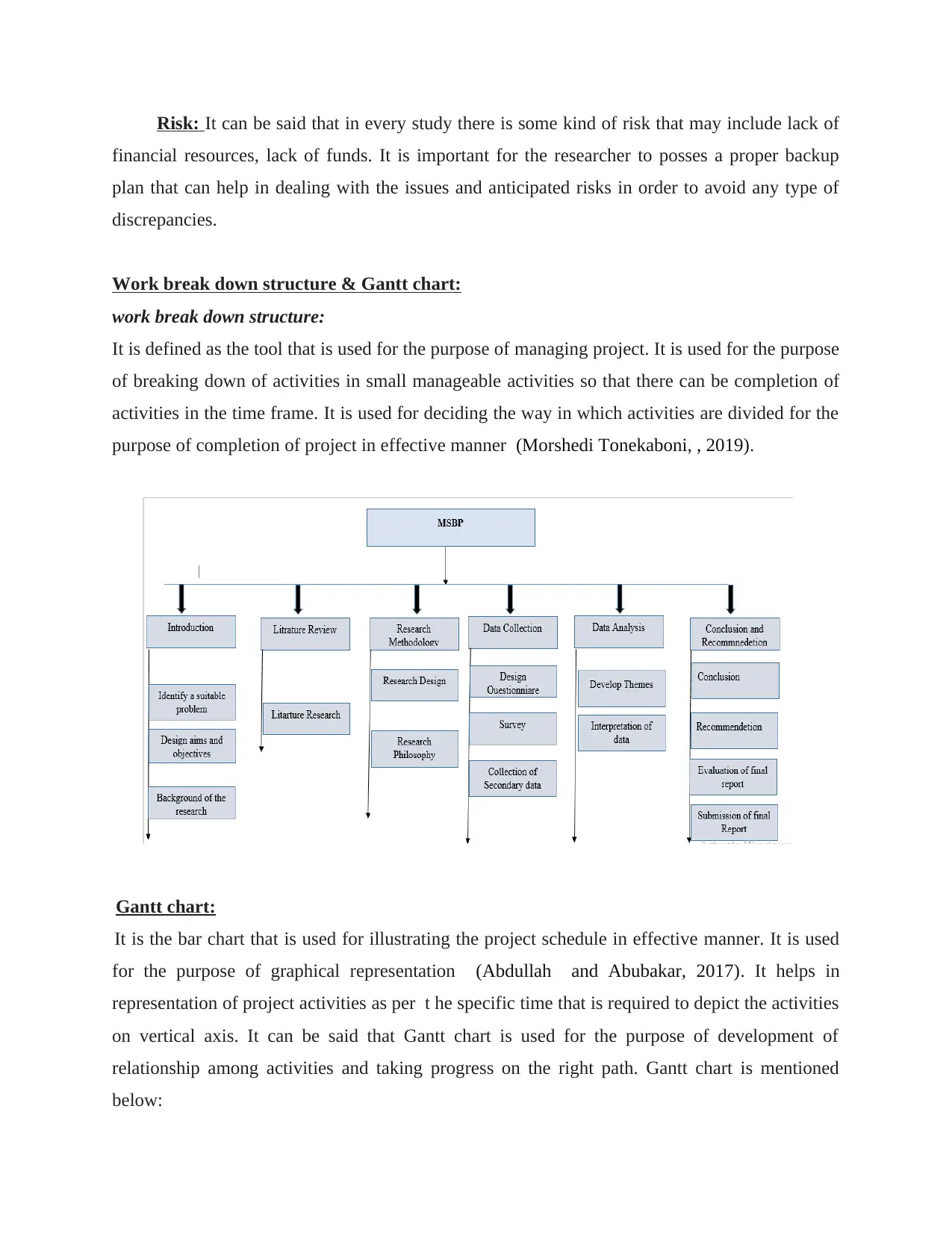
Risk: It can be said that in every study there is some kind of risk that may include lack of
financial resources, lack of funds. It is important for the researcher to posses a proper backup
plan that can help in dealing with the issues and anticipated risks in order to avoid any type of
discrepancies.
Work break down structure & Gantt chart:
work break down structure:
It is defined as the tool that is used for the purpose of managing project. It is used for the purpose
of breaking down of activities in small manageable activities so that there can be completion of
activities in the time frame. It is used for deciding the way in which activities are divided for the
purpose of completion of project in effective manner (Morshedi Tonekaboni, , 2019).
Gantt chart:
It is the bar chart that is used for illustrating the project schedule in effective manner. It is used
for the purpose of graphical representation (Abdullah and Abubakar, 2017). It helps in
representation of project activities as per t he specific time that is required to depict the activities
on vertical axis. It can be said that Gantt chart is used for the purpose of development of
relationship among activities and taking progress on the right path. Gantt chart is mentioned
below:
financial resources, lack of funds. It is important for the researcher to posses a proper backup
plan that can help in dealing with the issues and anticipated risks in order to avoid any type of
discrepancies.
Work break down structure & Gantt chart:
work break down structure:
It is defined as the tool that is used for the purpose of managing project. It is used for the purpose
of breaking down of activities in small manageable activities so that there can be completion of
activities in the time frame. It is used for deciding the way in which activities are divided for the
purpose of completion of project in effective manner (Morshedi Tonekaboni, , 2019).
Gantt chart:
It is the bar chart that is used for illustrating the project schedule in effective manner. It is used
for the purpose of graphical representation (Abdullah and Abubakar, 2017). It helps in
representation of project activities as per t he specific time that is required to depict the activities
on vertical axis. It can be said that Gantt chart is used for the purpose of development of
relationship among activities and taking progress on the right path. Gantt chart is mentioned
below:
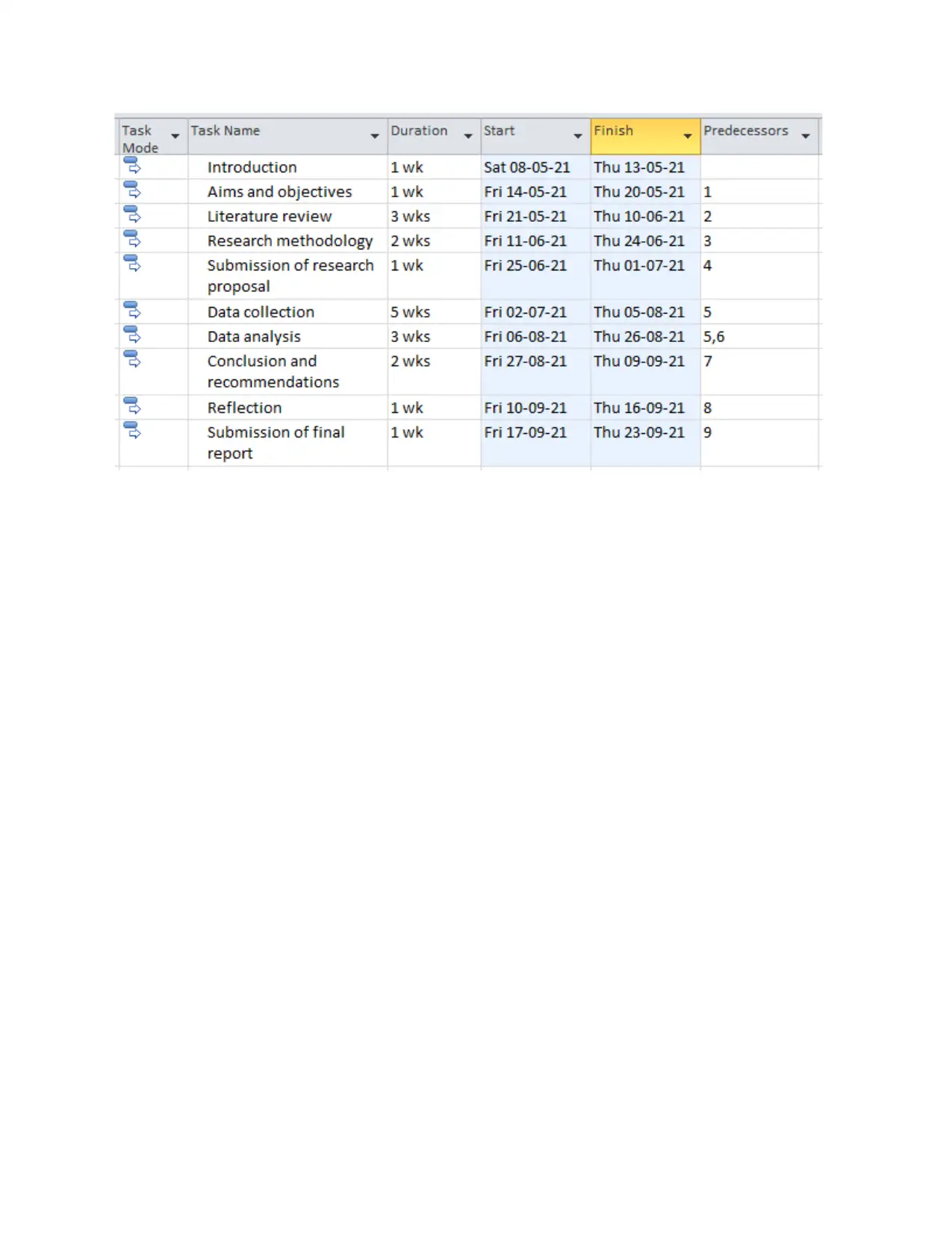
⊘ This is a preview!⊘
Do you want full access?
Subscribe today to unlock all pages.

Trusted by 1+ million students worldwide
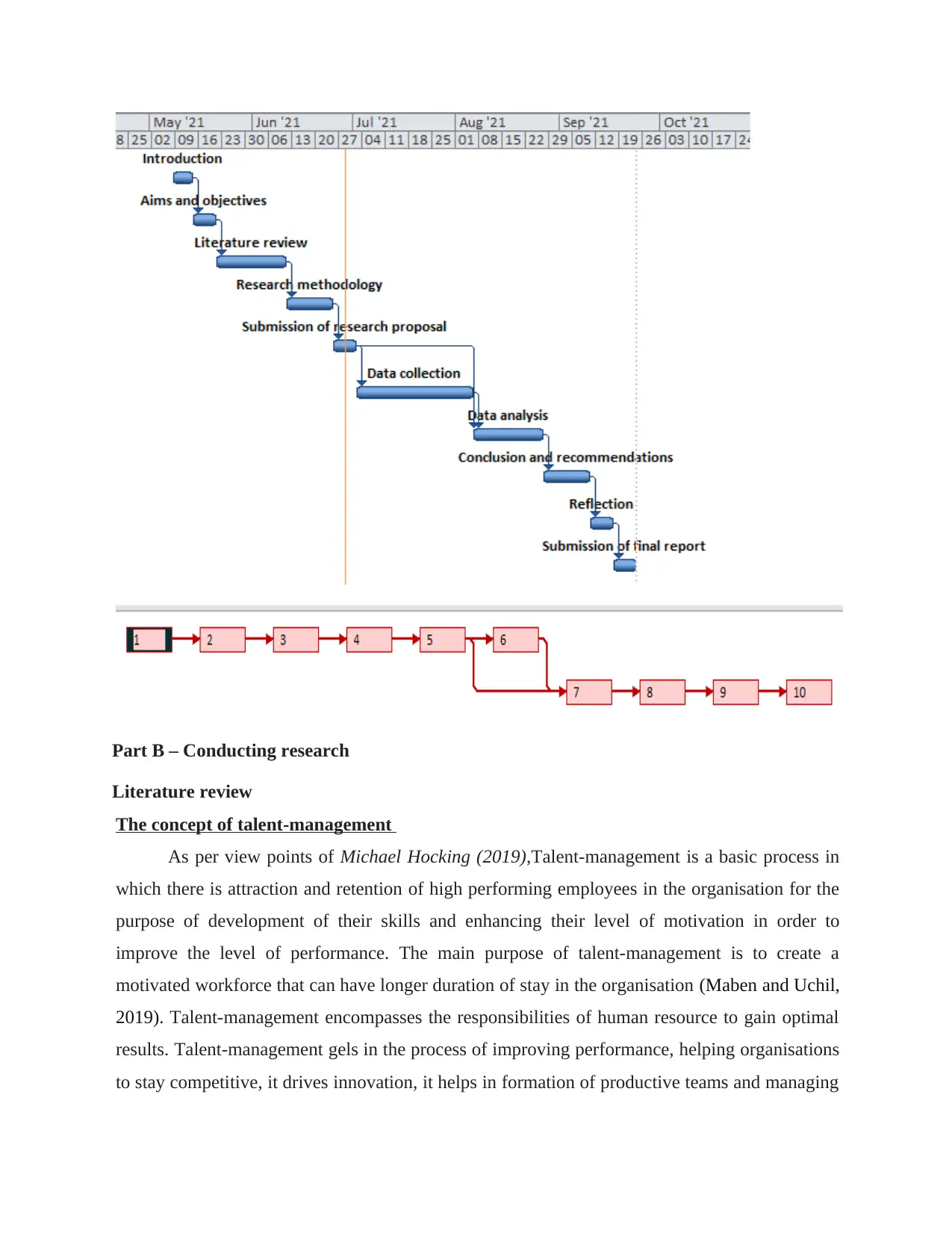
Part B – Conducting research
Literature review
The concept of talent-management
As per view points of Michael Hocking (2019),Talent-management is a basic process in
which there is attraction and retention of high performing employees in the organisation for the
purpose of development of their skills and enhancing their level of motivation in order to
improve the level of performance. The main purpose of talent-management is to create a
motivated workforce that can have longer duration of stay in the organisation (Maben and Uchil,
2019). Talent-management encompasses the responsibilities of human resource to gain optimal
results. Talent-management gels in the process of improving performance, helping organisations
to stay competitive, it drives innovation, it helps in formation of productive teams and managing
Literature review
The concept of talent-management
As per view points of Michael Hocking (2019),Talent-management is a basic process in
which there is attraction and retention of high performing employees in the organisation for the
purpose of development of their skills and enhancing their level of motivation in order to
improve the level of performance. The main purpose of talent-management is to create a
motivated workforce that can have longer duration of stay in the organisation (Maben and Uchil,
2019). Talent-management encompasses the responsibilities of human resource to gain optimal
results. Talent-management gels in the process of improving performance, helping organisations
to stay competitive, it drives innovation, it helps in formation of productive teams and managing
Paraphrase This Document
Need a fresh take? Get an instant paraphrase of this document with our AI Paraphraser
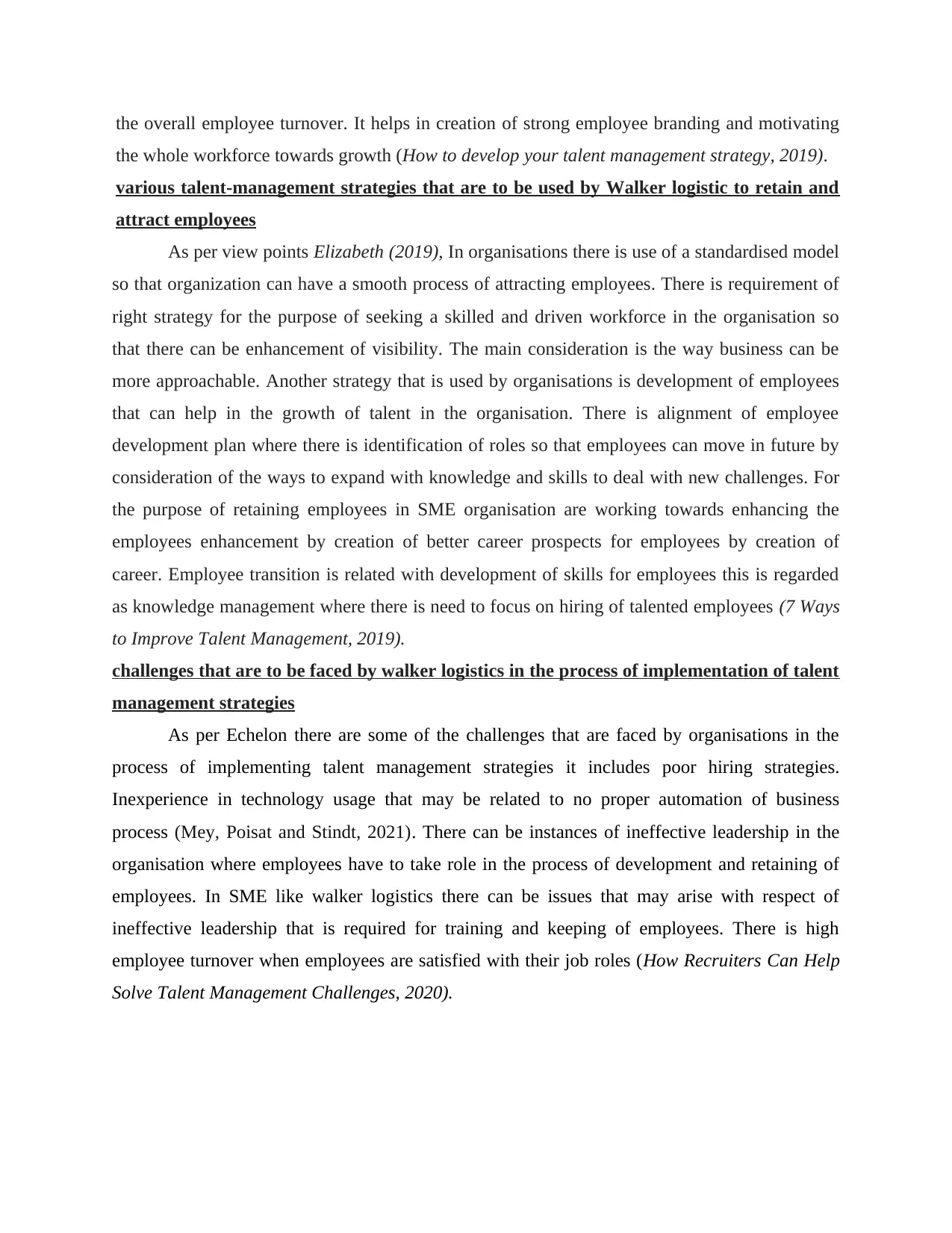
the overall employee turnover. It helps in creation of strong employee branding and motivating
the whole workforce towards growth (How to develop your talent management strategy, 2019).
various talent-management strategies that are to be used by Walker logistic to retain and
attract employees
As per view points Elizabeth (2019), In organisations there is use of a standardised model
so that organization can have a smooth process of attracting employees. There is requirement of
right strategy for the purpose of seeking a skilled and driven workforce in the organisation so
that there can be enhancement of visibility. The main consideration is the way business can be
more approachable. Another strategy that is used by organisations is development of employees
that can help in the growth of talent in the organisation. There is alignment of employee
development plan where there is identification of roles so that employees can move in future by
consideration of the ways to expand with knowledge and skills to deal with new challenges. For
the purpose of retaining employees in SME organisation are working towards enhancing the
employees enhancement by creation of better career prospects for employees by creation of
career. Employee transition is related with development of skills for employees this is regarded
as knowledge management where there is need to focus on hiring of talented employees (7 Ways
to Improve Talent Management, 2019).
challenges that are to be faced by walker logistics in the process of implementation of talent
management strategies
As per Echelon there are some of the challenges that are faced by organisations in the
process of implementing talent management strategies it includes poor hiring strategies.
Inexperience in technology usage that may be related to no proper automation of business
process (Mey, Poisat and Stindt, 2021). There can be instances of ineffective leadership in the
organisation where employees have to take role in the process of development and retaining of
employees. In SME like walker logistics there can be issues that may arise with respect of
ineffective leadership that is required for training and keeping of employees. There is high
employee turnover when employees are satisfied with their job roles (How Recruiters Can Help
Solve Talent Management Challenges, 2020).
the whole workforce towards growth (How to develop your talent management strategy, 2019).
various talent-management strategies that are to be used by Walker logistic to retain and
attract employees
As per view points Elizabeth (2019), In organisations there is use of a standardised model
so that organization can have a smooth process of attracting employees. There is requirement of
right strategy for the purpose of seeking a skilled and driven workforce in the organisation so
that there can be enhancement of visibility. The main consideration is the way business can be
more approachable. Another strategy that is used by organisations is development of employees
that can help in the growth of talent in the organisation. There is alignment of employee
development plan where there is identification of roles so that employees can move in future by
consideration of the ways to expand with knowledge and skills to deal with new challenges. For
the purpose of retaining employees in SME organisation are working towards enhancing the
employees enhancement by creation of better career prospects for employees by creation of
career. Employee transition is related with development of skills for employees this is regarded
as knowledge management where there is need to focus on hiring of talented employees (7 Ways
to Improve Talent Management, 2019).
challenges that are to be faced by walker logistics in the process of implementation of talent
management strategies
As per Echelon there are some of the challenges that are faced by organisations in the
process of implementing talent management strategies it includes poor hiring strategies.
Inexperience in technology usage that may be related to no proper automation of business
process (Mey, Poisat and Stindt, 2021). There can be instances of ineffective leadership in the
organisation where employees have to take role in the process of development and retaining of
employees. In SME like walker logistics there can be issues that may arise with respect of
ineffective leadership that is required for training and keeping of employees. There is high
employee turnover when employees are satisfied with their job roles (How Recruiters Can Help
Solve Talent Management Challenges, 2020).
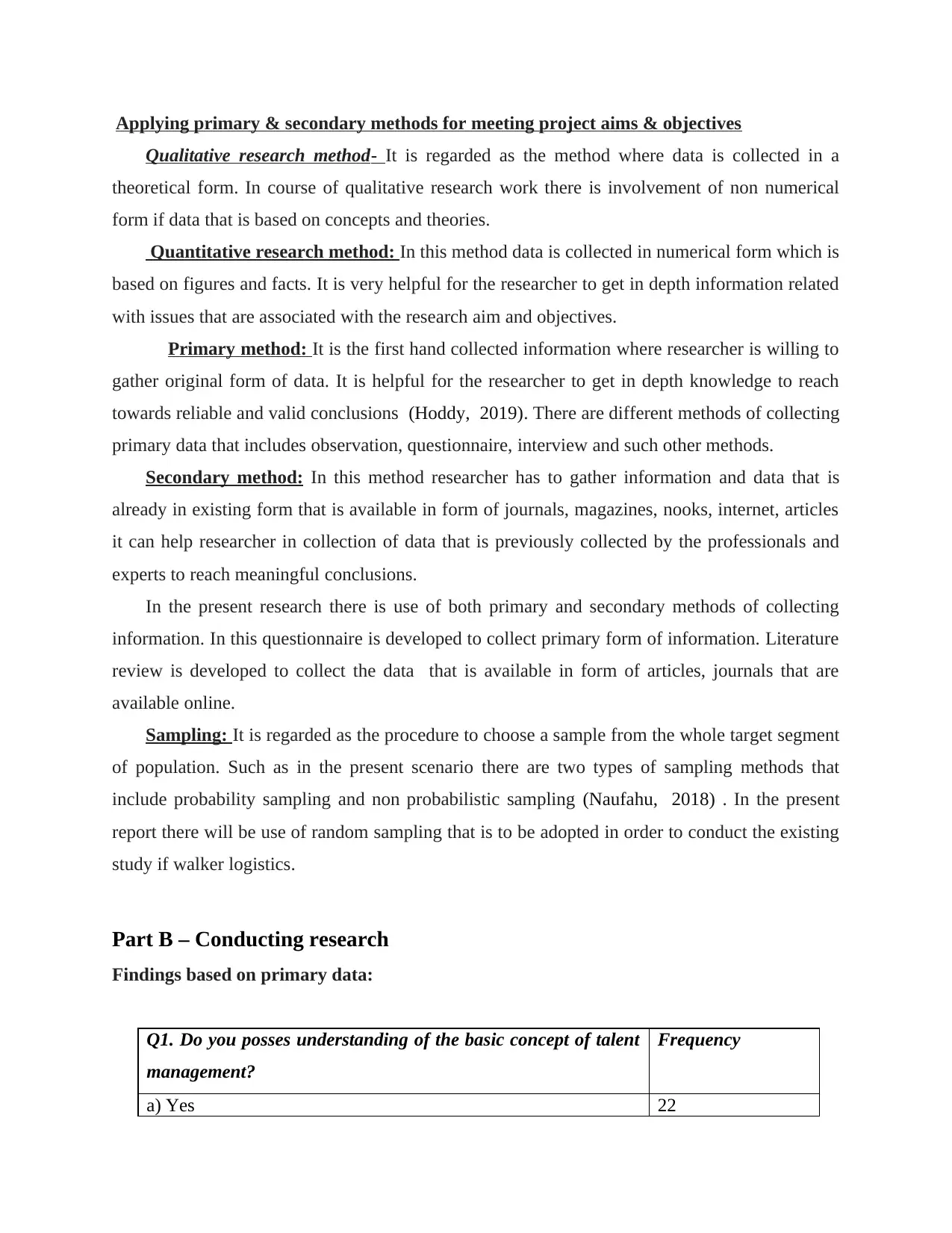
Applying primary & secondary methods for meeting project aims & objectives
Qualitative research method- It is regarded as the method where data is collected in a
theoretical form. In course of qualitative research work there is involvement of non numerical
form if data that is based on concepts and theories.
Quantitative research method: In this method data is collected in numerical form which is
based on figures and facts. It is very helpful for the researcher to get in depth information related
with issues that are associated with the research aim and objectives.
Primary method: It is the first hand collected information where researcher is willing to
gather original form of data. It is helpful for the researcher to get in depth knowledge to reach
towards reliable and valid conclusions (Hoddy, 2019). There are different methods of collecting
primary data that includes observation, questionnaire, interview and such other methods.
Secondary method: In this method researcher has to gather information and data that is
already in existing form that is available in form of journals, magazines, nooks, internet, articles
it can help researcher in collection of data that is previously collected by the professionals and
experts to reach meaningful conclusions.
In the present research there is use of both primary and secondary methods of collecting
information. In this questionnaire is developed to collect primary form of information. Literature
review is developed to collect the data that is available in form of articles, journals that are
available online.
Sampling: It is regarded as the procedure to choose a sample from the whole target segment
of population. Such as in the present scenario there are two types of sampling methods that
include probability sampling and non probabilistic sampling (Naufahu, 2018) . In the present
report there will be use of random sampling that is to be adopted in order to conduct the existing
study if walker logistics.
Part B – Conducting research
Findings based on primary data:
Q1. Do you posses understanding of the basic concept of talent
management?
Frequency
a) Yes 22
Qualitative research method- It is regarded as the method where data is collected in a
theoretical form. In course of qualitative research work there is involvement of non numerical
form if data that is based on concepts and theories.
Quantitative research method: In this method data is collected in numerical form which is
based on figures and facts. It is very helpful for the researcher to get in depth information related
with issues that are associated with the research aim and objectives.
Primary method: It is the first hand collected information where researcher is willing to
gather original form of data. It is helpful for the researcher to get in depth knowledge to reach
towards reliable and valid conclusions (Hoddy, 2019). There are different methods of collecting
primary data that includes observation, questionnaire, interview and such other methods.
Secondary method: In this method researcher has to gather information and data that is
already in existing form that is available in form of journals, magazines, nooks, internet, articles
it can help researcher in collection of data that is previously collected by the professionals and
experts to reach meaningful conclusions.
In the present research there is use of both primary and secondary methods of collecting
information. In this questionnaire is developed to collect primary form of information. Literature
review is developed to collect the data that is available in form of articles, journals that are
available online.
Sampling: It is regarded as the procedure to choose a sample from the whole target segment
of population. Such as in the present scenario there are two types of sampling methods that
include probability sampling and non probabilistic sampling (Naufahu, 2018) . In the present
report there will be use of random sampling that is to be adopted in order to conduct the existing
study if walker logistics.
Part B – Conducting research
Findings based on primary data:
Q1. Do you posses understanding of the basic concept of talent
management?
Frequency
a) Yes 22
⊘ This is a preview!⊘
Do you want full access?
Subscribe today to unlock all pages.

Trusted by 1+ million students worldwide
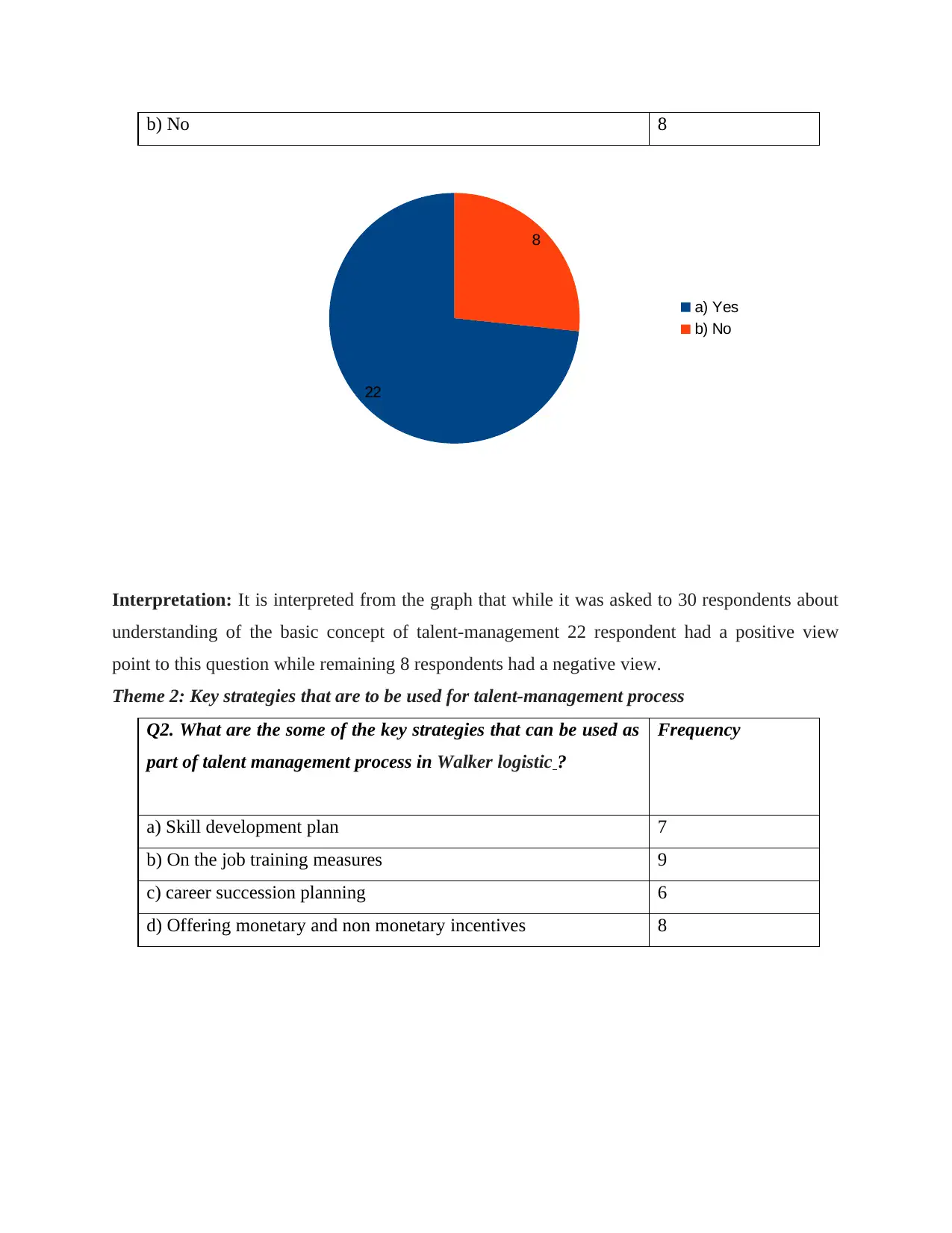
b) No 8
Interpretation: It is interpreted from the graph that while it was asked to 30 respondents about
understanding of the basic concept of talent-management 22 respondent had a positive view
point to this question while remaining 8 respondents had a negative view.
Theme 2: Key strategies that are to be used for talent-management process
Q2. What are the some of the key strategies that can be used as
part of talent management process in Walker logistic ?
Frequency
a) Skill development plan 7
b) On the job training measures 9
c) career succession planning 6
d) Offering monetary and non monetary incentives 8
22
8
a) Yes
b) No
Interpretation: It is interpreted from the graph that while it was asked to 30 respondents about
understanding of the basic concept of talent-management 22 respondent had a positive view
point to this question while remaining 8 respondents had a negative view.
Theme 2: Key strategies that are to be used for talent-management process
Q2. What are the some of the key strategies that can be used as
part of talent management process in Walker logistic ?
Frequency
a) Skill development plan 7
b) On the job training measures 9
c) career succession planning 6
d) Offering monetary and non monetary incentives 8
22
8
a) Yes
b) No
Paraphrase This Document
Need a fresh take? Get an instant paraphrase of this document with our AI Paraphraser
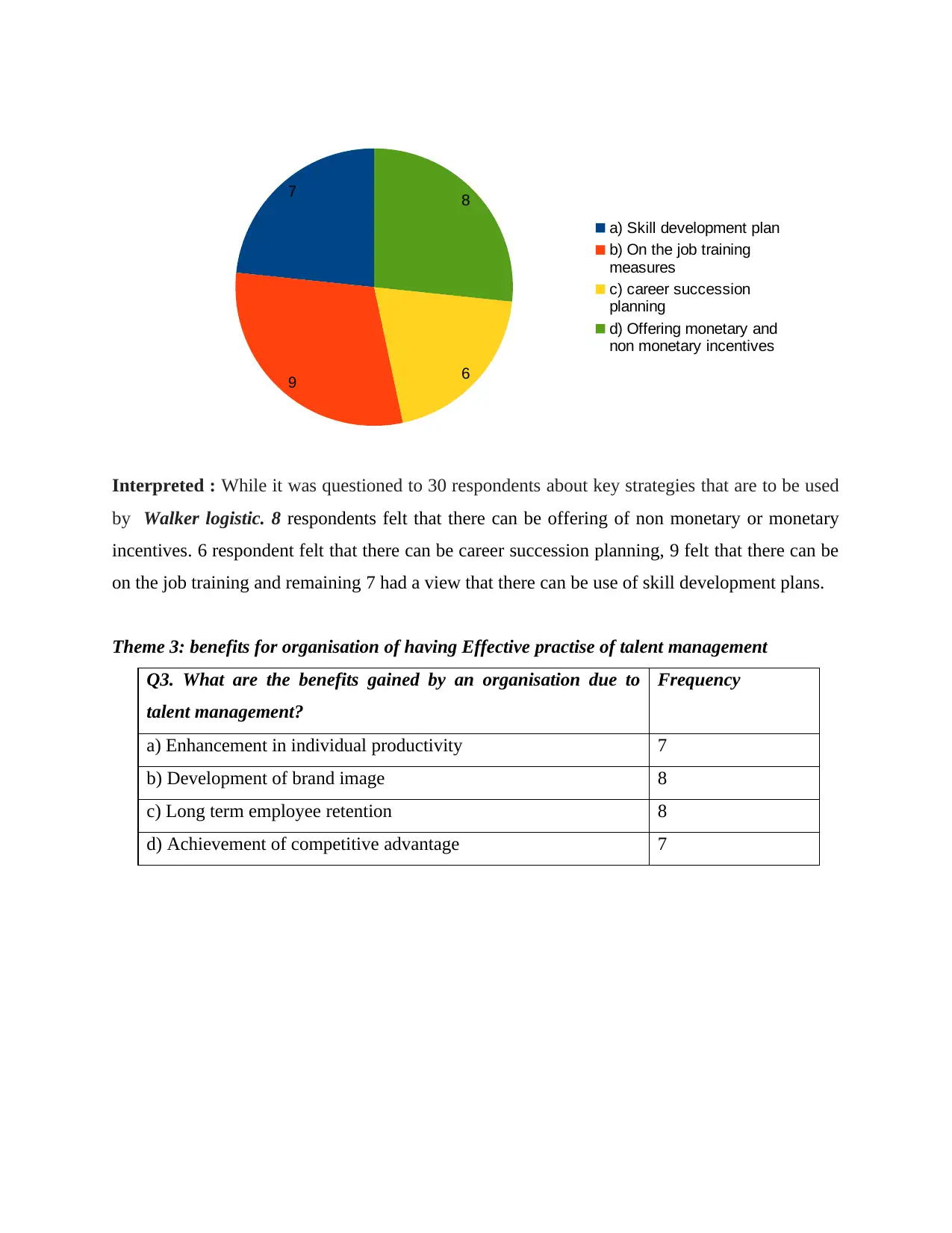
Interpreted : While it was questioned to 30 respondents about key strategies that are to be used
by Walker logistic. 8 respondents felt that there can be offering of non monetary or monetary
incentives. 6 respondent felt that there can be career succession planning, 9 felt that there can be
on the job training and remaining 7 had a view that there can be use of skill development plans.
Theme 3: benefits for organisation of having Effective practise of talent management
Q3. What are the benefits gained by an organisation due to
talent management?
Frequency
a) Enhancement in individual productivity 7
b) Development of brand image 8
c) Long term employee retention 8
d) Achievement of competitive advantage 7
7
9 6
8
a) Skill development plan
b) On the job training
measures
c) career succession
planning
d) Offering monetary and
non monetary incentives
by Walker logistic. 8 respondents felt that there can be offering of non monetary or monetary
incentives. 6 respondent felt that there can be career succession planning, 9 felt that there can be
on the job training and remaining 7 had a view that there can be use of skill development plans.
Theme 3: benefits for organisation of having Effective practise of talent management
Q3. What are the benefits gained by an organisation due to
talent management?
Frequency
a) Enhancement in individual productivity 7
b) Development of brand image 8
c) Long term employee retention 8
d) Achievement of competitive advantage 7
7
9 6
8
a) Skill development plan
b) On the job training
measures
c) career succession
planning
d) Offering monetary and
non monetary incentives
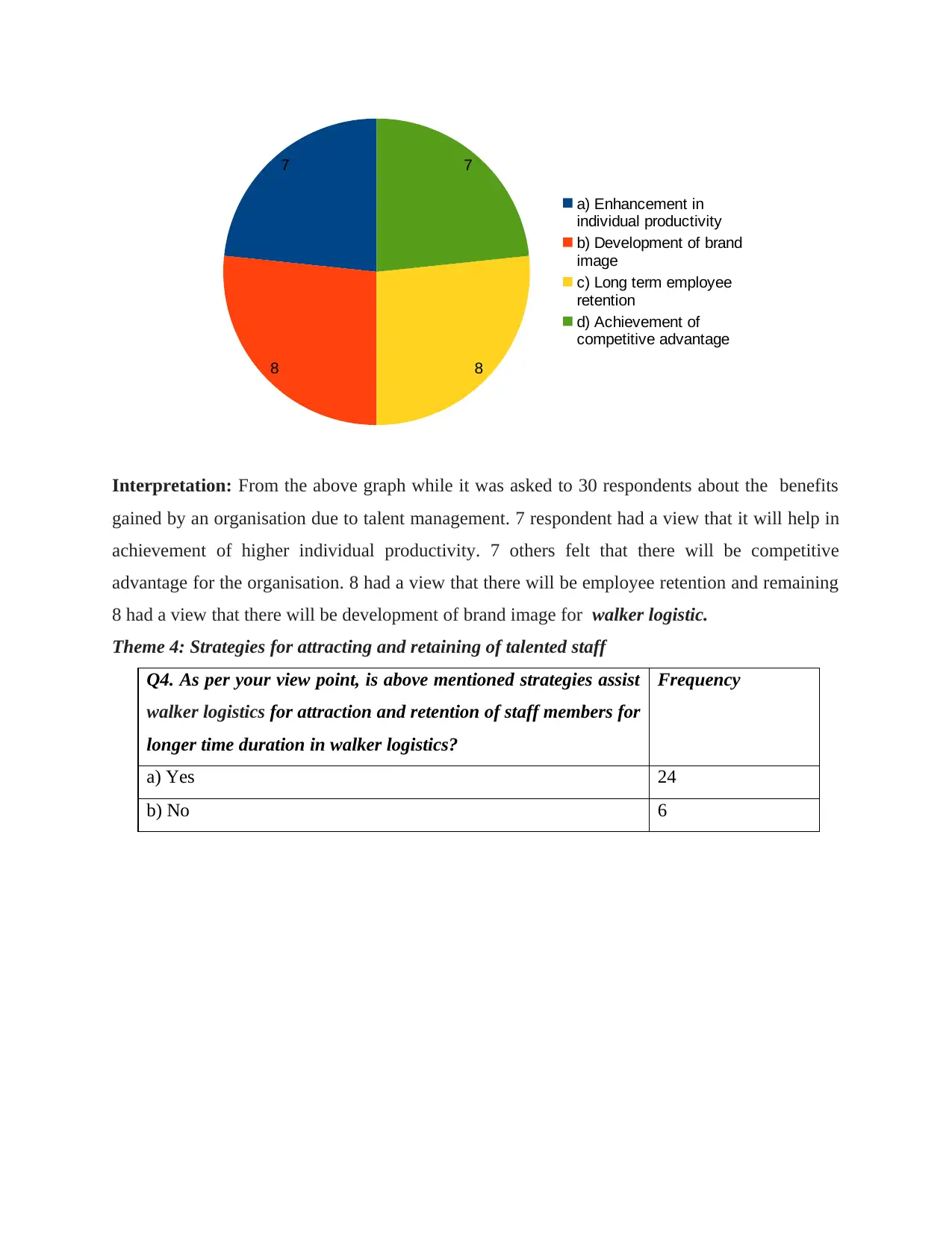
Interpretation: From the above graph while it was asked to 30 respondents about the benefits
gained by an organisation due to talent management. 7 respondent had a view that it will help in
achievement of higher individual productivity. 7 others felt that there will be competitive
advantage for the organisation. 8 had a view that there will be employee retention and remaining
8 had a view that there will be development of brand image for walker logistic.
Theme 4: Strategies for attracting and retaining of talented staff
Q4. As per your view point, is above mentioned strategies assist
walker logistics for attraction and retention of staff members for
longer time duration in walker logistics?
Frequency
a) Yes 24
b) No 6
7
8 8
7
a) Enhancement in
individual productivity
b) Development of brand
image
c) Long term employee
retention
d) Achievement of
competitive advantage
gained by an organisation due to talent management. 7 respondent had a view that it will help in
achievement of higher individual productivity. 7 others felt that there will be competitive
advantage for the organisation. 8 had a view that there will be employee retention and remaining
8 had a view that there will be development of brand image for walker logistic.
Theme 4: Strategies for attracting and retaining of talented staff
Q4. As per your view point, is above mentioned strategies assist
walker logistics for attraction and retention of staff members for
longer time duration in walker logistics?
Frequency
a) Yes 24
b) No 6
7
8 8
7
a) Enhancement in
individual productivity
b) Development of brand
image
c) Long term employee
retention
d) Achievement of
competitive advantage
⊘ This is a preview!⊘
Do you want full access?
Subscribe today to unlock all pages.

Trusted by 1+ million students worldwide
1 out of 25
Related Documents
Your All-in-One AI-Powered Toolkit for Academic Success.
+13062052269
info@desklib.com
Available 24*7 on WhatsApp / Email
![[object Object]](/_next/static/media/star-bottom.7253800d.svg)
Unlock your academic potential
Copyright © 2020–2025 A2Z Services. All Rights Reserved. Developed and managed by ZUCOL.




